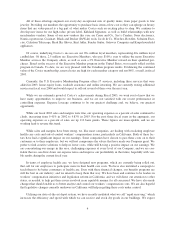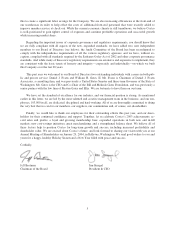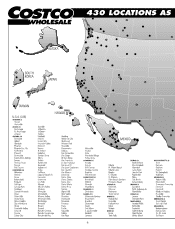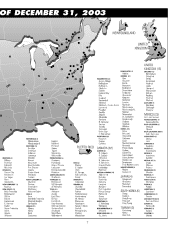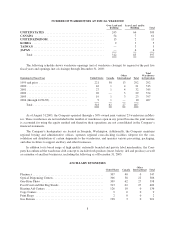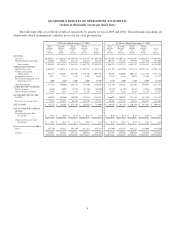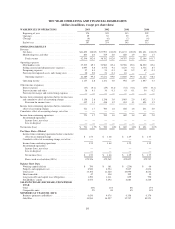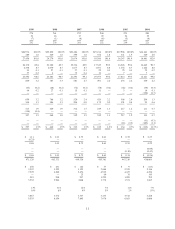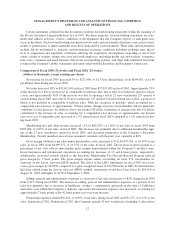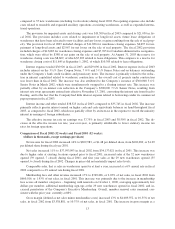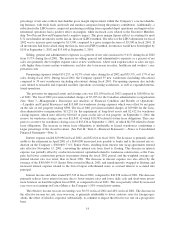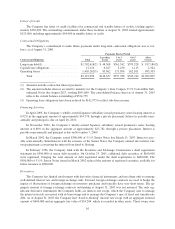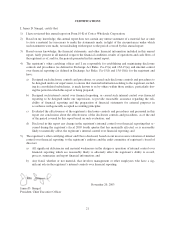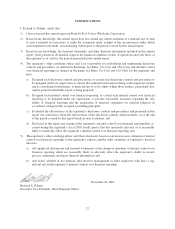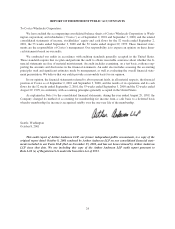Costco 2003 Annual Report Download - page 16
Download and view the complete annual report
Please find page 16 of the 2003 Costco annual report below. You can navigate through the pages in the report by either clicking on the pages listed below, or by using the keyword search tool below to find specific information within the annual report.percentage of net sales reflects merchandise gross margin improvement within the Company’s core merchandis-
ing business, with fresh foods and foods and sundries categories being the primary contributors. Additionally, a
reduction in the LIFO reserve, improved purchasing resulting from expanded depot operations and improved in-
ternational operations had a positive effect on margins, while increased costs related to the Executive Member-
ship Two-Percent Reward Program had a negative impact. The gross margin figures reflect accounting for most
U.S. merchandise inventories on the last-in, first-out (LIFO) method. The effect of the LIFO adjustment for fiscal
2002 was to increase gross margin by $13,500, compared to a gross margin decrease of $5,500 in fiscal 2001. If
all inventories had been valued using the first-in, first-out (FIFO) method, inventories would have been higher by
$150 at September 1, 2002 and $13,650 at September 2, 2001.
Selling, general and administrative expenses as a percent of net sales increased to 9.41% during fiscal 2002
from 9.17% during fiscal 2001. The increase in selling, general and administrative expenses as a percent of net
sales was primarily due to higher expense ratios at new warehouses, where such expense ratios to sales are typi-
cally higher than at more mature warehouses; and also due to increases in salary, healthcare and workers’ com-
pensation costs.
Preopening expenses totaled $51,257, or 0.13% of net sales, during fiscal 2002 and $59,571, or 0.17% of net
sales, during fiscal 2001. During fiscal 2002, the Company opened 35 new warehouses (including relocations)
compared to 39 new warehouses (including relocations) during fiscal 2001. Pre-opening expenses also include
costs related to remodels and expanded ancillary operations at existing warehouses, as well as expanded interna-
tional operations.
The provision for impaired assets and closing costs was $21,050 in fiscal 2002 compared to $18,000 in fis-
cal 2001. The fiscal 2002 provision included charges of $7,765 for the Canadian administrative reorganization
(See “Item 7—Management’s Discussion and Analysis of Financial Condition and Results of Operations”
—Liquidity and Capital Resources) and $13,683 for warehouse closing expenses which were offset by net gains
on the sale of real property totaling $398. The fiscal 2001 provision included charges of $19,000 for the Cana-
dian administrative reorganization, $15,231 for the impairment of long-lived assets and $2,412 for warehouse
closing expense, which were offset by $18,643 of gains on the sale of real property. At September 1, 2002, the
reserve for warehouse closing costs was $11,845, of which $10,395 related to future lease obligations. This com-
pares to a reserve for warehouse closing costs of $15,434 at September 1, 2001, of which $6,538 related to future
lease obligations. The increase in future lease obligations is attributable to leased warehouses constituting a
larger percentage of the closed locations. (See Part II, “Item 8—Financial Statements”—Notes to Consolidated
Financial Statements—Note 1).
Interest expense totaled $29,096 in fiscal 2002, and $32,024 in fiscal 2001. The decrease is primarily attrib-
utable to the retirement in April 2001 of a $140,000 unsecured note payable to banks and to the interest rate re-
duction on the Company’s $300,000 7
1
⁄
8
% Senior Notes, resulting from interest rate swap agreements entered
into effective November 13, 2001, converting the interest rate from fixed to floating. This decrease in interest
expense was partially offset by a reduction in interest capitalized related to warehouse construction, as the Com-
pany had fewer construction projects in progress during the fiscal 2002 period, and the weighted average cap-
italized interest rate was lower than in fiscal 2001. The decrease in interest expense was also offset by the
issuance of the $300,000 5
1
⁄
2
% Senior Notes issued in March, 2002, and simultaneously swapped to floating, and
increased interest expense related to the Zero Coupon subordinated notes as accrued interest is accreted into
principal.
Interest income and other totaled $35,745 in fiscal 2002, compared to $43,238 in fiscal 2001. The decrease
primarily reflects lower interest income due to lower interest rates and lower daily cash and short-term invest-
ment balances on hand throughout fiscal 2002, as compared to fiscal 2001. This was partially offset by increased
year-over-year earnings in Costco Mexico, the Company’s 50%-owned joint venture.
The effective income tax rate on earnings was 38.5% in fiscal 2002 and 40% in fiscal 2001. The decrease in
the effective income tax rate, year-over-year, is primarily attributable to lower statutory rates for foreign oper-
ations, the effect of which is expected, substantially, to continue to impact the effective tax rate on a prospective
basis.
14


